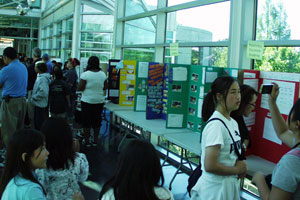 School groups tour the Oakland Schools Science Fair
School groups tour the Oakland Schools Science Fair
projects at Chabot. Ben Burress, Chabot Space & Science CenterIt's the time of year again that I get a chance to peruse what our scientific-minded youth are thinking on questions of the physical world and universe around us: Oakland Unified School District Science Fair!
The science projects of students from a range of schools in Oakland are on display at Chabot Space & Science Center for a couple of days-a long-time tradition I know, because when I was in elementary school (Glenview Elementary in Oakland) I participated in the Science Fair every year and wound up with my First Grade project (Which Straw Works Best-longer or shorter?) on display at Chabot Observatory on Mountain Blvd.
So I went out into our halls to browse the rows of free-standing cardboard displays (all pre-fabbed display boards; in my day we'd make our own from boxes, staples, and glue!) to see what today's young minds are thinking about science. In particular, I was looking for any that dealt with astronomy.
As usual, I saw a range of science topics, presentations styles, decoration, and grade levels. I saw the cadre of "standard" science projects that get done every year (the tabletop volcano, the floating egg, the electric potato, and the like).
I also saw some that I'd not seen before. There was one where the question asked was who has more germs, boys or girls? The experimenter took swab samples from behind the ears and from the hands of the students in her fourth grade class and grew germ cultures, which were all displayed before the presentation board in little plastic Petri dishes. What was the result? Do you want to know? Well, by this experiment at least, the girls won over the boys in having more germs from both sample sites....
